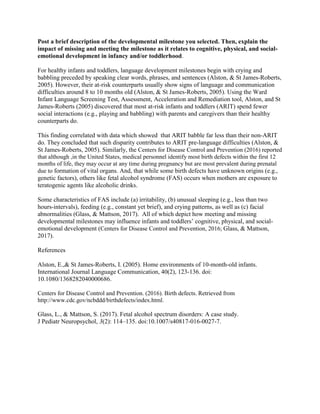DPSY 8215/ PSY Week 5 Discussion: Infancy and Childhood
- 1. Post a brief description of the developmental milestone you selected. Then, explain the impact of missing and meeting the milestone as it relates to cognitive, physical, and social- emotional development in infancy and/or toddlerhood. For healthy infants and toddlers, language development milestones begin with crying and babbling preceded by speaking clear words, phrases, and sentences (Alston, & St James-Roberts, 2005). However, their at-risk counterparts usually show signs of language and communication difficulties around 8 to 10 months old (Alston, & St James-Roberts, 2005). Using the Ward Infant Language Screening Test, Assessment, Acceleration and Remediation tool, Alston, and St James-Roberts (2005) discovered that most at-risk infants and toddlers (ARIT) spend fewer social interactions (e.g., playing and babbling) with parents and caregivers than their healthy counterparts do. This finding correlated with data which showed that ARIT babble far less than their non-ARIT do. They concluded that such disparity contributes to ARIT pre-language difficulties (Alston, & St James-Roberts, 2005). Similarly, the Centers for Disease Control and Prevention (2016) reported that although ,in the United States, medical personnel identify most birth defects within the first 12 months of life, they may occur at any time during pregnancy but are most prevalent during prenatal due to formation of vital organs. And, that while some birth defects have unknown origins (e.g., genetic factors), others like fetal alcohol syndrome (FAS) occurs when mothers are exposure to teratogenic agents like alcoholic drinks. Some characteristics of FAS include (a) irritability, (b) unusual sleeping (e.g., less than two hours-intervals), feeding (e.g., constant yet brief), and crying patterns, as well as (c) facial abnormalities (Glass, & Mattson, 2017). All of which depict how meeting and missing developmental milestones may influence infants and toddlers’ cognitive, physical, and social- emotional development (Centers for Disease Control and Prevention, 2016; Glass, & Mattson, 2017). References Alston, E.,& St James-Roberts, I. (2005). Home environments of 10-month-old infants. International Journal Language Communication, 40(2), 123-136. doi: 10.1080/1368282040000686. Centers for Disease Control and Prevention. (2016). Birth defects. Retrieved from http://www.cdc.gov/ncbddd/birthdefects/index.html. Glass, L., & Mattson, S. (2017). Fetal alcohol spectrum disorders: A case study. J Pediatr Neuropsychol, 3(2): 114–135. doi:10.1007/s40817-016-0027-7.

